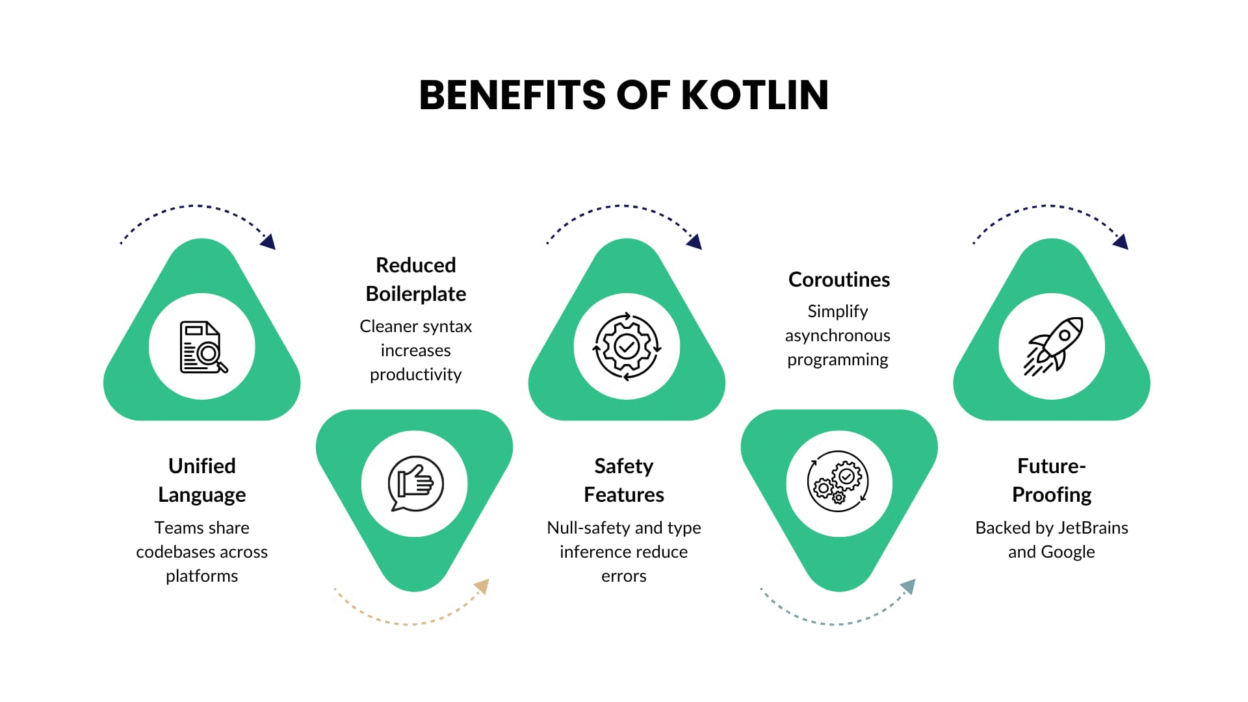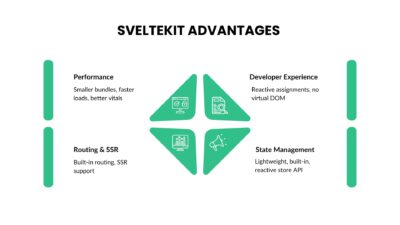For years, Kotlin has been synonymous with Android app development. When Google announced official support for Kotlin in 2017, the language quickly became the go-to choice for Android developers. Its concise syntax, null-safety features, and seamless interoperability with Java positioned Kotlin as a powerful modern alternative.
But Kotlin’s journey didn’t stop at mobile. Thanks to JetBrains’ vision, the language has grown far beyond Android, making serious inroads into backend, server-side, and even full-stack development. Today, Kotlin competes with established backend languages like Java, Node.js, and Python—while also offering the promise of full-stack development with Kotlin Multiplatform.
In this article, we’ll explore how Kotlin is expanding beyond Android, its role in backend and full-stack development, and why technical teams should pay attention to this shift.
Why Kotlin Is Expanding Beyond Android
Kotlin was designed as a general-purpose language from the beginning. While Android adoption was its first big success, JetBrains always intended Kotlin to solve broader developer problems.
Several factors fuel its expansion:
- Interoperability with Java: Kotlin runs on the JVM, which powers a large ecosystem of backend frameworks and libraries.
- Modern syntax: Cleaner, safer, and more concise than Java, reducing boilerplate.
- Performance: Kotlin compiles down to efficient JVM bytecode, with optimizations for server workloads.
- Kotlin Multiplatform (KMP): Enabling code sharing between mobile, web, and backend.
- Growing ecosystem: Frameworks like Ktor and Spring Boot Kotlin DSLs allow seamless backend development.
Kotlin for Backend Development
JVM Advantage
Kotlin’s JVM roots make it an immediate candidate for backend work. Developers can use existing Java libraries and frameworks while writing more modern and concise Kotlin code. This means teams can incrementally adopt Kotlin without rewriting entire systems.
Ktor Framework
Ktor, developed by JetBrains, is one of the standout frameworks for Kotlin backend development.
- Asynchronous by design – Built on Kotlin coroutines for high-performance non-blocking I/O.
- Lightweight and modular – Unlike heavy frameworks, Ktor lets developers choose only the features they need.
- REST APIs & WebSockets – Ideal for building modern microservices and real-time applications.
Example: A simple Ktor server route
fun Application.module() {
routing {
get(“/hello”) {
call.respondText(“Hello, Kotlin Backend!”, ContentType.Text.Plain)
}
}
}
Spring Boot with Kotlin
Spring remains the most popular Java backend framework, and Kotlin integrates beautifully with it:
- Kotlin DSLs simplify configuration.
- Extension functions reduce boilerplate in repositories and services.
- Data classes replace verbose Java POJOs.
This makes Kotlin + Spring Boot a powerful combination for enterprises transitioning from Java-heavy stacks.
Real-World Backend Use Cases
Companies are already adopting Kotlin for backend services:
- Gradle (the build automation tool) is migrating its codebase to Kotlin.
- Corda, a distributed ledger platform, uses Kotlin for smart contracts and backend logic.
- Atlassian and Pinterest are using Kotlin for parts of their backend systems.
Kotlin for Full-Stack Development
Kotlin is not stopping at backend—it’s pushing into full-stack development with Kotlin Multiplatform.
Kotlin Multiplatform (KMP)
KMP allows developers to write shared code (business logic, models, data layers) in Kotlin and reuse it across:
- Android
- iOS
- Web (via Kotlin/JS)
- Backend (via Kotlin/JVM)
This means teams can build a single codebase for multiple platforms while still writing native UIs.
For example:
- Networking & Data Models → Shared Kotlin code.
- UI → Platform-specific (SwiftUI on iOS, Jetpack Compose on Android, React/JS for Web).
Kotlin/JS
Kotlin can compile to JavaScript, allowing developers to write frontend web apps in Kotlin. With React wrappers, developers can build SPAs while keeping the same language across backend and frontend.
Example of Kotlin/JS with React DSL:
fun RBuilder.hello() {
div {
+”Hello from Kotlin/JS!”
}
}
Kotlin/Native
For performance-critical applications, Kotlin/Native compiles directly to machine code (without the JVM). This expands Kotlin into areas like desktop apps, embedded systems, and iOS development.
Kotlin vs Other Backend and Full-Stack Languages
| Feature | Kotlin | Java | Node.js (JavaScript) | Python |
| Syntax | Concise, null-safe | Verbose, reliable | Async-first, dynamic | Simple, dynamic |
| Performance | High (JVM optimized) | High (JVM) | High (event-driven) | Moderate (GIL) |
| Ecosystem | Growing (Ktor, Spring) | Mature | Huge (npm) | Huge (Django, Flask) |
| Multiplatform | Yes (KMP, JS, Native) | No | No | Limited |
| Learning Curve | Moderate | Easy for Java devs | Easy for JS devs | Easy |
| Enterprise Adoption | Rising | Established | High in startups | High in data/AI |
Benefits of Choosing Kotlin Beyond Android

- Unified language for teams: Mobile, backend, and web teams can share codebases.
- Reduced boilerplate: Cleaner syntax increases productivity.
- Safety: Null-safety and type inference reduce runtime errors.
- Coroutines: Simplify asynchronous programming, outperforming callback-heavy Java/JavaScript code.
- Future-proof: Backed by JetBrains and Google, Kotlin is here to stay.
Challenges in Kotlin’s Expansion
Despite the benefits, adopting Kotlin outside Android has challenges:
- Smaller ecosystem compared to Java and JavaScript.
- Learning curve for teams used to Java or Python.
- KMP maturity: While improving rapidly, Kotlin Multiplatform is still evolving.
- Tooling gaps: Some libraries/frameworks are not as Kotlin-optimized as they are for Java.
The Future of Kotlin in Backend and Full-Stack
Kotlin is moving from being a “mobile-first language” to becoming a general-purpose development powerhouse. With strong community adoption, increasing enterprise backing, and a focus on multiplatform development, Kotlin is positioned to:
- Challenge Node.js and Python for modern microservices.
- Offer enterprises a smooth migration path from Java.
- Enable shared codebases across Android, iOS, Web, and Backend.
Final Thoughts
Kotlin has proven it is more than just an Android language. With strong backing, JVM interoperability, and multiplatform capabilities, it’s rapidly becoming a serious option for backend and full-stack development.
For technical teams, Kotlin offers the best of both worlds: modern developer productivity and enterprise-level reliability. As the ecosystem matures, adopting Kotlin across your stack may not just be a smart move—it could be the competitive advantage your team needs
FAQs
Q1: Is Kotlin good for backend development?
Yes. Kotlin integrates seamlessly with Java-based frameworks like Spring Boot and offers native backend frameworks like Ktor, making it a strong backend choice.
Q2: Can Kotlin replace Java in backend systems?
Not immediately, but Kotlin can coexist with Java. Many teams incrementally migrate Java codebases to Kotlin due to interoperability.
Q3: What is Kotlin Multiplatform?
Kotlin Multiplatform (KMP) allows developers to share code across Android, iOS, Web, and backend, reducing duplication and speeding up cross-platform development.
Q4: Is Kotlin used in production for backend?
Yes. Companies like Gradle, Atlassian, and Corda use Kotlin in backend production environments.
Q5: How does Kotlin compare to Node.js for microservices?
Kotlin with Ktor offers strong async capabilities via coroutines, similar to Node.js. However, Kotlin benefits from JVM performance and type safety, making it better suited for enterprise-grade systems.
.


